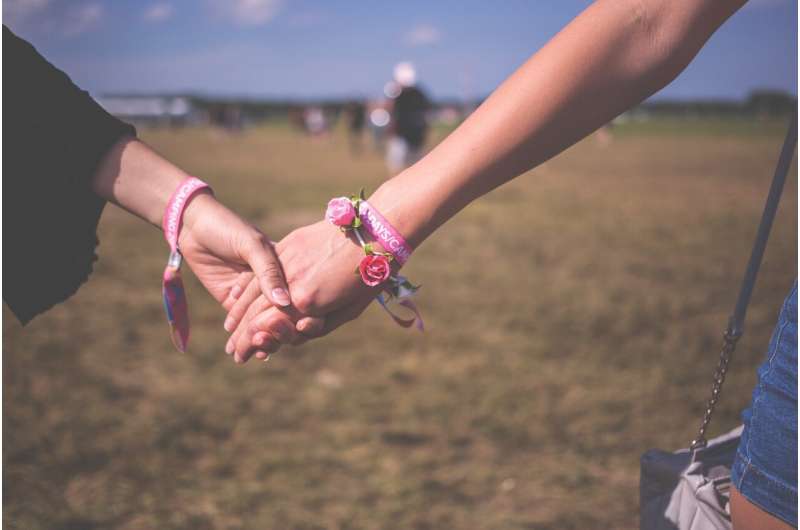New research shows the term 'lesbian' is declining in popularity. The reasons why are complex

Run your eyes down a list of famous women who have recently come out and you're likely to see people describe themselves as pansexual, bisexual or queer, or insist on their right not to label their sexuality at all. With one or two notable exceptions, you'd be forgiven for thinking the word "lesbian" has gone out of fashion.
New research conducted by the University of Sydney and community health organization confirms the label has declined in popularity over the past decade. In 2014, 69% of respondents described themselves as lesbian. In 2020 .
Results of the 2024 survey, due to be released in the new year, will show the downward trend has continued: just 38% of 1,436 non-heterosexual women surveyed in 2024 chose the label "lesbian."
What accounts for this change?
Lesbian+
In 2020, the Australian Bureau of Statistics for government agencies asking people about their sexual orientation. The ABS standard recommends people be instructed to pick only one sexuality label when filling out surveys.
Yet a significant proportion of SWASH survey respondents have always ticked multiple boxes. When the survey went online due to the pandemic, we formally allowed respondents to select multiple identity labels. The result? In 2024, 27% of 1,436 women choose more than one sexuality label.
When researchers allow more flexibility, a more complex picture than simply declining popularity emerges. While 38% only ticked lesbian in SWASH 2024, 55% ticked lesbian or lesbian plus another label (e.g., lesbian and queer).
While the number of people who primarily identify as lesbian might have declined, lesbian remains an important label for over half of the women surveyed.
What other labels do women chose?
Of the remaining respondents in the 2024 survey, 18% ticked only queer (with 42% queer or queer plus something else), 15% ticked only bisexual (28% bisexual or bisexual plus something else), and 2% ticked another label.
Results from a 2019 of LGBTQ people aged 14 to 21 year suggest the trend away from "lesbian" is more pronounced for young people: 45% of cisgender women identified as bisexual, 19% lesbian, 10% pansexual, 7% queer, 4.5% asexual and 10.7% "something else."
The survey found lesbian was more popular among young trans women (23.6%), where it sat alongside pansexual (23.6%) as one of the most common labels.
Interestingly, shows non-heterosexual, cisgender men are far less likely to identify as bisexual or pansexual than non-heterosexual cisgender women. This difference may reflect narrower community norms about sexual desire, behavior and identity for cisgender men.
It is not uncommon for women to choose different labels across their life course. A of women born between 1989 and 1995 found 30% had changed their sexual identity label at least once during the four times they were surveyed.
These changes may reflect a woman's current relationship context, her comfort with available labels, or changes in her experience of her sexuality. We know from and research that there are often differences between how women label their sexuality and their sexual behavior or experience of attraction.
Same sex, different label?
Since the 19th century, we have seen sex, desire and pleasure as a neatly aligned bundle of experiences connected to a person's identity. We started to label these bundles "homosexual" and "heterosexual" (although the exact meaning of those terms has ).
Sex, desire and pleasure are complex phenomena, however, and lots of different stories can be told about them.
Indeed, at different historical junctures very different stories have been told. argues that in early modern times in England and France, the primary medical and legal frameworks for understanding sex between women focused on very specific (penetrative) sexual acts, rather than seeing those as connected to desire, attraction, romance or sexual "orientation."
There are debates about when exactly we came to understand women's same-sex desire in the way we do to today. (written partly in code between 1806 and 1840, deciphered in the 1930s, and first published in 1988) are thought by some to be the , although she didn't use that term herself. Lister's life was most famously dramatized in the 2019–2022 BBC-HBO drama .
The term "" emerged in the 1990s out of major social changes. Queer was not just a new word for the same experience, but a new way of thinking about sexuality and sexual politics. It challenged the idea of stable, innate sexual "identities" and rebelled against rigid sexual norms.
Different cultures can also have different ways of understanding sex, desire and intimacy. In China the term "lala" is sometimes defined as "lesbian, bisexual, and woman-loving transgender people," although its everyday usage is sometimes more narrow (closer to lesbian). Within lala communities people sometimes further identify as either .
Our understanding of sexuality is so closely tied to culture that seeking easy equivalence between terms is a fraught exercise. Differences in the words we use to describe sexuality often reflect deeper differences in how people make sense of what sexuality is.
While "lesbian" continues to resonate with many non-heterosexual women, other women are showing us that the "straight/lesbian" binary does not—and likely never did—fully reflect the complexity of women's experiences.
Some may be drawn to terms that suggest more fluidity. Some prefer terms that do not frame their sexuality primarily in relation to the gender of their intimate partners.
Rather than seeing this as a superficial change, akin to fashion, the changes in how women use the word lesbian tell us something important about the rich ways they make sense of their sexuality.
Provided by The Conversation
This article is republished from under a Creative Commons license. Read the .![]()

















